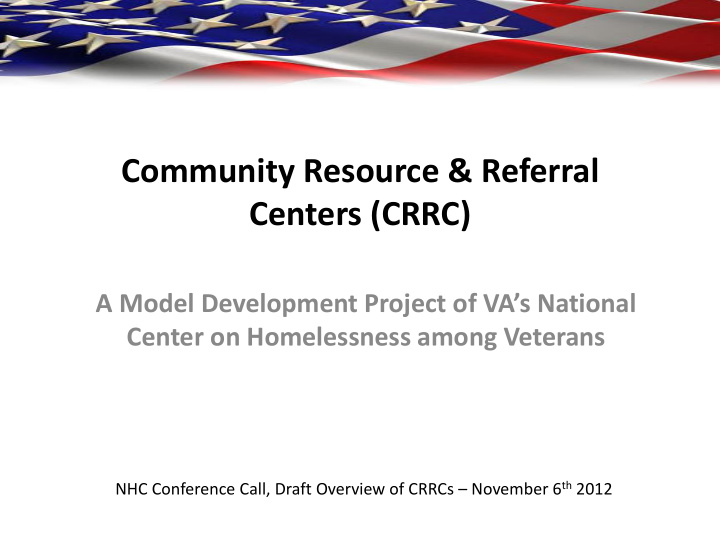



Community Resource & Referral Centers (CRRC) A Model Development Project of VA’s National Center on Homelessness among Veterans NHC Conference Call, Draft Overview of CRRCs – November 6 th 2012
The CRRC Mission To provide one stop service centers in collaboration with local community partners to serve both homeless Veterans and Veterans at risk for homelessness and their families
The CRRC Vision To provide space in a community store front setting that is accessible to the homeless where Federal, state, and local community partners can join VA staff in a one stop setting to provide comprehensive services for homeless and “at risk” Veterans and their families with a goal of preventing or ending their homelessness
Basic Requirements • Secure store front community accessible space • Provide space free of charge to collaborating community partners thru a sharing agreement or memorandum of understanding • Maintain operations seven days per week, directly or through referral • Provide showers and laundry facilities on site or thru sharing agreements • Provide access to food and clothing services via non-profit community providers • Provide rapid referral to housing services (emergency and permanent) • Provide medical and mental health services either on site or by referral • Provide comprehensive services to prevent and/or end homelessness directly or by referral
Core Principles • Welcoming environment • Low threshold to entry/easy access to services • Urban store front locations • Leveraging community partners • Comprehensive service array on-site (co- • located) • Rapid access to primary, specialty and behavioral health care • Rapid access to housing 5
CRRCs Provide a Hub for a Comprehensive Response to Homelessness CRRCs converge seven key components — all critical to tackling the underlying issues that lead to homelessness • Early identification of at-risk Veterans Prevention • Reduce Stigma Benefits & • VBA Partnerships Mental Employment • Access to Substance use and Health • Education Services Assistance Behavioral Health Treatment • Resume Support • Vocational Rehabilitation Community Resource & Referral Center • Federal, state, and local • Patient-Centered, Community Primary Care Partnerships support Coordinated Care • Assessment • Outreach • Access and Referral Case Housing • Long-term support Management to available housing options
The First Model Development Sites • New York (Harlem), NY • Akron, OH • New Orleans • Atlanta, GA • Omaha, NE • Chicago, IL • Philadelphia, PA • Cleveland, OH • Phoenix, AZ • Denver, CO • Portland, OR • Des Moines, IA • San Francisco, CA • Detroit, MI • Washington, DC • Las Vegas, NV • Minneapolis, MS (VISN Funded)
Coordination With Hotline • CRRC Staff are used at most sites to respond to calls from homeless hotline • CRRCs serve as entry point and coordinator of services to hotline callers
Special Guidance for Providing The Following Services • Food • Transportation • Laundry • Showers
Provision of Expanded Service Hours • Assessment of Need • Safety Considerations • Collaboration with Community Partners for Expanded Service Hours
Employment and Income Services • Coordination with VA, Federal and State Employment Programs • Coordination with Benefits and Economic Assistance Providers
Developmental Stages • Site Selection/Lease/Site Modification • Recruitment and Hiring of VA Staff • Identification and Recruitment of Community Partners • Planning and Implementation of Key CRRC Components • Community Announcement/Public Affairs Activities • Program Evaluation/Data Management Activities
Leasing Space and Contracting for Services Coordination with: • Capital Asset Managers • Engineering Staff • Contracting Staff
Lessons Learned • Demand for Prevention Services and Prevention Providers • Including Employment Assistance Providers • Storage Bins and Lockers • Computer access and E-mail services • Bed bug/pest control needs • Staffing, securing space, and meeting the timetable to become operational in nine months
CRRC Evaluation • Fidelity – Program Measures – Adherence to Models • Administrative -VA Staff Workload Capture -COMMUNITY Partner Workload Capture • Long term Follow-up • Outcomes
Recommend
More recommend